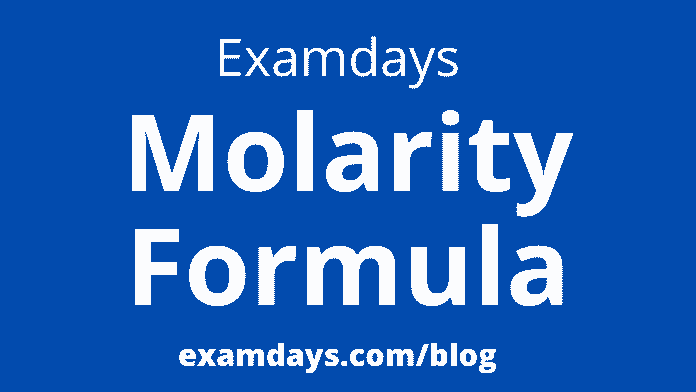The molarity is a given solution defined as the total number of moles of solute in one liter of solution. The molality of a solution depends on changes in the system’s physical properties, such as pressure and temperature. Unlike mass, the volume of a system changes with a difference in the physical conditions of the system.
Molarity is denoted by M, which is called molar. A molar is the molarity of a solution, where one gram of solute dissolves in one liter of solution. As we know, in a solution, the mixture of solute and solute forms a solution. Therefore the total volume of the solution is taken.
Molarity Formula
It has the formula where the student has to calculate the complete formula for molarity; some of the theories state that the molarity formula in grams and mixture formula and SI unit will be calculated.
Molarity is equal to the ratio of moles of the solute whose molarity is to be calculated and the amount of solvent used to dissolve the given solution. Now that you have studied what a mole is, you can easily calculate the solute present in a particular solution. After learning the definition and formula of molarity, you can try some examples to show how molarity can differ and how it can be determined.
M = n/V
M is the molality of the solution that is to be calculated
n is the no. of moles of the solute
V is the vol of the solution given in terms of liters.
Molarity has units of mole/liter, which can be abbreviated as molar. The molarity of a solution is usually abbreviated by placing square brackets around the formula of the solution. For example, the concentration of chloride ions during solution is often written as [Cl−].
Molarity SI Unit
it has the SI unit information for candidates looking for the information for exams; the detailed info has been listed for the candidate’s reference purpose.
The lower unit for molarity in the System International SI unit is mol/m3. The notation for those conventional units is usually prefixed with the letters M and SI to denote sub-multiples. The mole volume of the solution must be divided by the total liters produced. This is an excellent way to calculate molarity. If the volume of the solution is in grams, we must first calculate the no. of solutes’ molar mass, then calculate the molarity using the number of moles and the total volume.
Molarity Property
Molarity s gives the total molar density, which is the mixture’s density divided by the mix’s molar mass, or in other name, the reciprocal of the molar volume of the mix. In an ionic solution, the ionic strength is proportional to the molarity of the salts. Molarity depends mainly on the variation in the volume of the solution due to thermal expansion.
Difference between Molarity and Molality
- Both molarity and molality are the methods to represent the concentration of the solution.
- Molarity is the more moles of solute present in one liter of solution.
- In contrast, Molality is defined as the number of moles of solute present in one kilogram of solvent.
Although the terms molarity and molality are almost the same, students need to understand and know the sharp difference between them and their usage because it creates a huge difference when used.to perform various calculations. It is difficult to notice and sometimes escape students’ attention, but there is an essential difference between the two terms, molarity and molality. Molarity focuses on the number of moles of solute per liter of solution, whereas molality deals with moles of solute per kilogram of solution. Molarity is denoted by ‘M’ or molar or mol/L, while molality is meant by ‘m’ or molal or mol/kg.
The molarity of the solution depends on temperature and varies inversely with it. If the temperature increases, the molarity decreases, and if the temperature decreases, the molarity increases.
The molarity value is also affected by the change in pressure. The value of molarity is either exact or imprecise.
The molality is independent of changes in temperature and pressure. This is because the solvent mass is not affected by any changes in temperature and pressure.
The molarity of solution can be defined as moles of solute dissolved in one liter of solution. In contrast, solution molality can be defined as the moles of solute dissolved in one kilogram of solution.
Conclusion:
Molarity, the same thing as Molar concentration, is defined as the amount of a substance (in mole) present in 1L of water. Its mathematical formula, therefore, is:
Molarity = mole of the substance / volume(L)
Since “mole” is measured in mol, volume in L (or dm3), hence, the unit of molarity is mol/dm3
M = n/v
M = Molar Concentration, n = moles of solute, and v = liters of solution.
mol/m3
Examdays Article Agenda
Join Examdays Telegram
For more details about the Telegram Group, Click the Join Telegram below button.
In case of any doubt regarding Telegram, you can mail us at [email protected].



